Temperature stickers and other non-electronic temperature indicators
Introduction to temperature indicators
When the
need arises for measuring
temperatures in various industrial
situations, most engineers think in terms
of expensive electronic temperature
measuring equipment. In many cases,
though, you can do the job with less
costly and much simpler methods. When
the need is only for an indication that a
pre-determined temperature has or has
not been reached, heat-sensitive
materials in the form of crayons, paints,
pellets, or labels can do the job readily,
inexpensively, and accurately enough for
most industrial applications.
These heat-sensitive, fusible materials
consist of crystalline solids. When heated,
a temperature will be reached in which
the solids change sharply to a liquid. The
melting point is reproducible and is
virtually unaffected by ambient conditions
that may cause errors with other
temperature-sensing methods. For
example, electrical means of measuring
temperatures often function erratically in
the presence of static electricity, electrical
“noise” or ionized air near electrical
equipment.
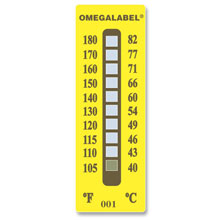
Learn more about temperature indicators
Temperature Labels
Another variation of the
phase-change indicators is the
temperature sensitive label. These
adhesive backed monitors consist of one
or more heat sensitive indicators sealed
under transparent, heat-resistant
windows. The centers of these indicators
turn from white to black at the
temperature ratings as shown on the
label face. This color change, caused by
the temperature-sensitive substance
being absorbed into its backing material,
is irreversible. After registering the
temperature history of the workpiece, the
exposed monitor label can then be
removed and affixed to a service report to
remain part of a permanent record.
Temperature Crayons
all the fusible indicators is the
temperature sensitive stick, or crayon.
Each crayon has a calibrated melting
point. These indicators are manufactured
in 100 different temperature ratings and
range from 100°F to 2500°F. Each has a
temperature indicating accuracy within
1% of its temperature rating.
Using the crayons is simple. The
workpiece to be tested is marked with a
crayon. When the pre-determined melting
point of the crayon mark is attained, the
mark instantly liquifies, notifying the
observer that the workpiece has reached
that temperature.
However, under some circumstances,
premarking with a crayon is not practical.
This can be the case if a prolonged
heating period is involved (the crayon
mark may evaporate), if the surface is
highly polished and does not readily
accept a crayon mark, or if the material
being marked is such that it absorbs the
liquid phase of the crayon. In such
instances, the operator can repeatedly
stroke the workpiece with the crayon. The
point at which the surface reaches the
desired temperature is determined by
noting when the crayon ceases to make
dry marks and instead leaves a liquid
smear.
Temperature Lacquers

Another form of heat
sensitive material is a dull lacquer-type
liquid that turns glossy and transparent at
a predetermined temperature. This phase
changing liquid is a fusible coating
material that offers greater flexibility than
crayons as to the types of surfaces on
which it can be applied.
Chemically, this lacquer-type fluid
contains a solid material that has a
calibrated melting point. These solids are
suspended in an inert, volatile, but nonflammable
vehicle. Upon reaching its
rated temperature, the dull lacquer mark
liquifies. On subsequent cooling,
however, the fluid does not revert to its
original dull appearance, but rather to a
glossy or crystalline coating. This shiny
state of appearance is evidence that the
lacquer has reached the rated
temperature.
Due to their physical properties, these
lacquers are often used instead of
crayons on very smooth surfaces (glass,
plastic film, laminated plastic), soft
surfaces (paper, cloth), or on surfaces not
readily accessible for application of a
crayon mark during heating. Within
seconds after application, the lacquer
dries to a dull matte finish. Response is
only a fraction of a second when the
temperature to be indicated is reached.
This time can be reduced to milliseconds
by applying a mark of minimal thickness.
These fluids are available in over 100
different temperature ratings, covering the
range from 100°F to 2500°F. As with the
crayon type indicators, accuracy is within
±1%. The temperature ratings available
range from 100°F to 350°F in
6 increments, from 350°F to 500°F in
12 increments, from 500°F to 750°F in
25 increments, and from 750°F to 2500°F
in 50 increments.
The temperature-sensitive lacquers are
supplied in the proper consistency for
brushing. If spraying or dipping is
preferred, a special thinner is added to
alter the viscosity without impairing the
temperature indicating performance.
Temperature Pellets
The first commercial form of
the fusible indicator was the pellet, which
continues to be useful in certain
applications. Pellets are most frequently
employed when extended heating periods
are involved or when oxidation of a metal
workpiece might obscure a crayon mark.
Pellets are also ideal when a relatively
large bulk of indicator material is
necessary because observations must be
made from a distance. Another major use
of pellet-type indicators is for determining
specific air-space temperatures. A typical
application is the monitoring of heat
zones in industrial ovens and furnaces.
Phase change temperature indicating
pellets are available in flat tablets, 7/16” in
diameter and 1/8” thick. For special
applications, smaller 1/8” by 1/8” thick pellets
are also available. One application for
these miniature pellets is that of thermal
fuses. The solid pellet acts as a circuit
breaker as it melts and releases tension
on a spring which, in relaxing, opens a
contact, in turn, cutting off electrical
continuity.
Pellets come in the extended range from
100°F to 3000°F. For temperature
measurements in hydrogen, carbon
monoxide, or other reducing
environments, a special series of pellets
is also available.
Choose the right temperature indicators
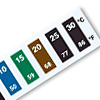 Reversible temperature sticker
Reversible temperature sticker
Reversible liquid crystal sensor labels change appearance once a certain temperature is reached and can be used over and over.
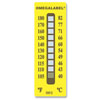 Non-reversible temperarture sticker
Non-reversible temperarture sticker
Irreversible sensor labels change appearance once a certain temperature is reached. These can be handy when one needs confirmation that the temperature of a piece of equipment or a material has not exceeded a certain level.
 pt100 Probes
pt100 Probes
Easy to use temperature kits, simply mark with the correct temperature color and when the temperature is reached, the mark changes.
Frequently Asked Questions
Advantages over electronic devices
This family of fusible temperature
indicators has several advantages over
other methods of determining surface
temperature. First, the temperature
indications obtained are unquestionably
those of the surface being tested. The
temperature sensitive material is applied
directly to the surface, and therefore
changes state in direct response to that
surface, and only that surface.
A second advantage of using fusible
temperature indicators is the fact that
there is no delay in obtaining a signal.
Since a mark left by a crayon or a lacquer
has an extremely small mass, it attains
rapid equilibrium with the surface. The
use of a “massive” probe tends to prolong
response time and could result in an
erroneously low reading. With the use of
fusible temperature indicators, there is no
conduction of heat away from the
surface. Nor is there any dependence on
the duration of heating.
The third advantage of fusible indicators
is that the technique for using them is
simple and economical. Determining
surface temperatures by most other
means requires some technical
competence and skill and, in many cases,
sophisticated instrumentation. Surface
temperature readings can be obtained
from fusible indicators with little effort,
training, and expense.
What is the difference between Non-Reversible and Reversible Temperature stickers?
As implied by the name, reversible temperature strips can change back and forth as needed to provide an indication of the present temperature. One advantage of the reversible stickers is that they can be used over and over again. Non-reversible temperature stickers are a one time usage indication that the specified temperature has been reached. Non-reversible stickers are useful in a situation where an operator is not available or does not have access to the sticker attached to a product under test. At any future time a non-reversible sticker may be examined to see if the specified temperature had been obtained.
What are Non-Reversible Temperature labels?
OMEGALABEL™ irreversible self adhesive temperature strips consist of one or more heat sensitive indicators sealed under transparent, heat-resistant windows. The centers of the temperature indicator circles will turn black at the temperature ratings shown on the sticker. The change to black is irreversible and registers the temperature history of the work piece. The exposed OMEGALABEL™ can be made part of the permanent record by removing it and affixing it to a service report. These conveniently applied and easy-to-interpret temperature indicating tabs find many industrial and military uses, as well as applications in research and development programs. The OMEGALABEL™ will indicate a specified temperature or sequence of temperatures. The performance of the OMEGALABEL™ is typically not affected by transient contact with solvents, gasoline, fuel oil, lubricants, hot water, or steam. The OMEGALABEL™ is particularly useful in the solution of problems, which include: monitoring the safe operating temperature of equipment and processes; determining temperatures as a guide to design and material selection in research and development projects; determining temperatures as a guide to design and material selection in research and development projects; safeguarding temperature sensitive materials in storage and transit; obtaining operating temperature data of components and regions not readily accessible to other methods. To use the OMEGALABEL™, remove the backing, exposing the adhesive; press the OMEGALABEL™ firmly to the work surface. No special treatment is needed for the surface, although it should be clean and dry to obtain maximum adhesion.
Temperature Labels | Related Products
↓ View this page in another language or region ↓
 CLOSE
CLOSE


 Another form of heat
sensitive material is a dull lacquer-type
liquid that turns glossy and transparent at
a predetermined temperature. This phase
changing liquid is a fusible coating
material that offers greater flexibility than
crayons as to the types of surfaces on
which it can be applied.
Another form of heat
sensitive material is a dull lacquer-type
liquid that turns glossy and transparent at
a predetermined temperature. This phase
changing liquid is a fusible coating
material that offers greater flexibility than
crayons as to the types of surfaces on
which it can be applied.


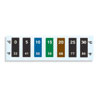
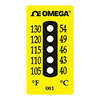
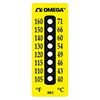
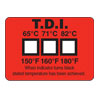
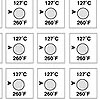

 Etiquetas de Temperatura
Etiquetas de Temperatura Étiquettes de Température
Étiquettes de Température Etiquetas de Temperatura
Etiquetas de Temperatura Etiquetas de Temperatura
Etiquetas de Temperatura Temperature Labels
Temperature Labels Temperaturindikatorlabels
Temperaturindikatorlabels Etiquettes de Température
Etiquettes de Température Temperaturaufkleber
Temperaturaufkleber Etichette per Temperatura
Etichette per Temperatura Temperature Labels
Temperature Labels Indicadoras de Temperatura
Indicadoras de Temperatura Temperature Labels
Temperature Labels Temperature Labels
Temperature Labels 温度标签
温度标签 Temperature Labels
Temperature Labels
 温度ラベル
温度ラベル 온도라벨
온도라벨 Temperature Labels
Temperature Labels
 Temperature Labels
Temperature Labels
 Temperature Labels
Temperature Labels
 Temperature Labels
Temperature Labels
 Temperature Labels
Temperature Labels